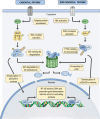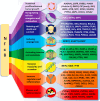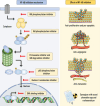The multifaceted NF-kB: are there still prospects of its inhibition for clinical intervention in pediatric central nervous system tumors?
- PMID: 34333711
- PMCID: PMC11072991
- DOI: 10.1007/s00018-021-03906-7
The multifaceted NF-kB: are there still prospects of its inhibition for clinical intervention in pediatric central nervous system tumors?
Abstract
Despite advances in the understanding of the molecular mechanisms underlying the basic biology and pathogenesis of pediatric central nervous system (CNS) malignancies, patients still have an extremely unfavorable prognosis. Over the years, a plethora of natural and synthetic compounds has emerged for the pharmacologic intervention of the NF-kB pathway, one of the most frequently dysregulated signaling cascades in human cancer with key roles in cell growth, survival, and therapy resistance. Here, we provide a review about the state-of-the-art concerning the dysregulation of this hub transcription factor in the most prevalent pediatric CNS tumors: glioma, medulloblastoma, and ependymoma. Moreover, we compile the available literature on the anti-proliferative effects of varied NF-kB inhibitors acting alone or in combination with other therapies in vitro, in vivo, and clinical trials. As the wealth of basic research data continues to accumulate, recognizing NF-kB as a therapeutic target may provide important insights to treat these diseases, hopefully contributing to increase cure rates and lower side effects related to therapy.
Keywords: Inhibitors; NF-kB; Pediatric tumors; Treatment.
© 2021. The Author(s), under exclusive licence to Springer Nature Switzerland AG.
Conflict of interest statement
Nothing to declare.
Figures








References
Publication types
MeSH terms
Substances
Grants and funding
LinkOut - more resources
Full Text Sources
Research Materials

